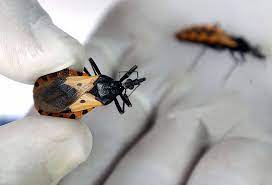Hey everyone, we got you good news about Chagas diseases, know about Chagas Diseases and 5 best preventive tips, this article will put you through and get you guided.
Chagas disease, also known as American trypanosomiasis, is a potentially life-threatening illness caused by the parasite Trypanosoma cruzi. Named after the Brazilian physician Carlos Chagas who first discovered it in 1909, this neglected tropical disease primarily affects individuals in Latin America, although cases have been reported in other regions due to globalization and migration.
Chagas disease is transmitted to humans primarily through the bite of infected triatomine bugs, commonly known as “kissing bugs.” However, transmission can also occur through congenital means, blood transfusions, organ transplantation, and consumption of contaminated food or beverages.
Once infected, individuals may progress through acute and chronic stages, with symptoms ranging from mild to severe. Chronic Chagas disease can lead to serious cardiac and gastrointestinal complications, often years or decades after the initial infection, Know about Chagas Diseases and 5 best preventive tips.
Know about Chagas Diseases and 5 best preventive tips
Despite being recognized as a significant public health concern, Chagas disease remains largely overlooked and underfunded, particularly in resource-limited settings where it disproportionately affects impoverished communities with inadequate access to healthcare services.
Efforts to control Chagas disease include vector control measures, blood screening programs, improved diagnostic tools, and research into more effective treatments and preventive strategies. However, numerous challenges persist in combating this complex and multifaceted disease, highlighting the need for continued awareness, research, and international collaboration to mitigate its impact and ultimately eliminate it as a global health threat.
Transmission routes of chagas diseases
Chagas disease can be transmitted through several routes, each with its own set of risk factors and implications. Here are the detailed transmission routes, Know about Chagas Diseases and 5 best preventive tips.
- Vector-Borne Transmission:
- Triatomine bugs, also known as “kissing bugs” or “assassin bugs,” are the primary vectors responsible for transmitting Chagas disease.
- These bugs are commonly found in rural and peri-urban areas of Latin America, where they inhabit cracks and crevices in poorly constructed houses.
- Transmission occurs when an infected triatomine bug bites a human host and deposits Trypanosoma cruzi parasites in the wound or mucous membranes, typically during feeding.
- The parasite can then enter the bloodstream and spread throughout the body, establishing infection.
- Congenital Transmission:
- Pregnant women infected with Trypanosoma cruzi can transmit the parasite to their babies during pregnancy or childbirth.
- Congenital transmission can occur even if the mother is asymptomatic or unaware of her infection status.
- Infants born to infected mothers are at risk of developing congenital Chagas disease, which can lead to serious health complications if left untreated, Know about Chagas Diseases and 5 best preventive tips
- Blood Transfusion and Organ Transplantation:
- Chagas disease can be transmitted through the transfusion of infected blood or blood products.
- Similarly, organ transplantation from an infected donor can transmit the parasite to the recipient.
- Although blood screening and organ donor testing have reduced the risk of transmission, cases still occur, particularly in regions where Chagas disease is endemic and screening measures may be inadequate.
- Oral Transmission: Know about Chagas Diseases and 5 best preventive tips
- Consumption of food or beverages contaminated with Trypanosoma cruzi parasites can lead to oral transmission of Chagas disease.
- This route of transmission is often associated with traditional practices such as drinking contaminated juices or ingesting food contaminated with triatomine bug feces, Know about Chagas Diseases and 5 best preventive tips.
- Outbreaks of oral Chagas disease have been reported in endemic areas, highlighting the importance of food safety and hygiene measures.
Each of these transmission routes presents unique challenges for disease control and prevention. Efforts to reduce the burden of Chagas disease require a comprehensive approach that addresses vector control, blood screening, prenatal care, safe blood transfusion practices, and public health education to raise awareness about the risks and prevention strategies associated with each transmission route.
Causes of chagas diseases
Here are few causes or contributing factors to the spread and persistence of Chagas disease:
- Triatomine Bug Infestation: The presence of infected triatomine bugs, which serve as vectors for Trypanosoma cruzi, is a primary cause of Chagas disease transmission, particularly in rural and peri-urban areas of Latin America.
- Poor Housing Conditions: Inadequate housing, characterized by cracks and crevices in walls and roofs, provides suitable habitats for triatomine bugs, increasing the risk of human-vector contact and subsequent transmission of the parasite, Know about Chagas Diseases and 5 best preventive tips.
- Lack of Vector Control Measures: Insufficient efforts to control and eliminate triatomine bug populations, such as insecticide spraying and housing improvements, contribute to ongoing transmission of Chagas disease in endemic regions.
- Limited Access to Healthcare Services: In regions where Chagas disease is endemic, barriers to healthcare access, including poverty, geographic isolation, and inadequate healthcare infrastructure, prevent timely diagnosis and treatment of infected individuals.
- Low Awareness and Education: Limited awareness about Chagas disease among at-risk populations and healthcare providers leads to delays in seeking medical care, missed diagnoses, and ineffective disease management.
- Congenital Transmission: Infected pregnant women can unknowingly transmit the parasite to their babies during pregnancy or childbirth, perpetuating the cycle of transmission and increasing the burden of congenital Chagas disease, Know about Chagas Diseases and 5 best preventive tips
- Unsafe Blood Transfusions and Organ Transplants: Despite efforts to screen blood donors and organ donors for Chagas disease, lapses in screening protocols or the use of inadequately screened blood or organs can result in the transmission of the parasite to recipients.
- Migration and Travel: Movement of infected individuals from endemic regions to non-endemic areas, as well as travel-related exposure to Chagas disease, contribute to the global spread of the infection and the emergence of new transmission cycles.
- Urbanization and Deforestation: Environmental changes associated with urbanization, deforestation, and human encroachment into natural habitats can alter the distribution of triatomine bugs and increase the risk of human-vector contact, leading to new outbreaks of Chagas disease.
- Climate Change: Shifts in temperature and precipitation patterns associated with climate change may impact the geographic distribution and abundance of triatomine bugs, influencing the transmission dynamics of Chagas disease and potentially expanding its range into new areas.
Addressing these underlying causes and risk factors is essential for effective Chagas disease control and prevention efforts, requiring a multidisciplinary approach that integrates vector control, improved access to healthcare, community education, and sustainable development strategies.
Preventive tips to chagas diseases
Below are four detailed preventive approaches to Chagas disease:
- Vector Control Measures:
- Implement comprehensive vector control programs aimed at reducing the population of triatomine bugs, the primary vectors of Trypanosoma cruzi.
- Conduct indoor residual spraying with insecticides to eliminate or reduce triatomine bug infestations in homes, particularly in rural and peri-urban areas where Chagas disease is endemic.
- Promote housing improvements and environmental modifications to reduce human-vector contact, such as sealing cracks in walls and roofs, installing screens on windows and doors, and using insecticide-treated materials.
- Blood Screening and Safe Transfusion Practices:
- Implement routine screening of blood donors for Chagas disease in endemic regions and areas with a high prevalence of infection, Know about Chagas Diseases and 5 best preventive tips
- Utilize sensitive and specific diagnostic tests, such as serological assays and nucleic acid amplification techniques, to detect Trypanosoma cruzi infection in blood donations.
- Ensure the use of screened and safe blood and blood products for transfusions, organ transplants, and other medical procedures to prevent the iatrogenic transmission of Chagas disease.
- Prenatal Screening and Care:
- Offer prenatal screening for Chagas disease to pregnant women in endemic regions to identify infected mothers and their infants at risk of congenital transmission.
- Provide early diagnosis and treatment for pregnant women diagnosed with Chagas disease to reduce the risk of vertical transmission to their babies.
- Offer appropriate medical care and follow-up for infants born to infected mothers, including monitoring for signs of congenital Chagas disease and timely initiation of treatment if necessary.
- Health Education and Community Empowerment:
- Conduct community-based health education campaigns to raise awareness about Chagas disease transmission, symptoms, prevention, and treatment options.
- Empower individuals and communities to take proactive measures to protect themselves from Chagas disease, such as practicing good hygiene, using insect repellents, and seeking prompt medical attention for suspected infections.
- Foster community participation and collaboration in vector control activities, housing improvements, and other preventive interventions to create sustainable, locally-driven approaches to Chagas disease control.
- International Collaboration and Research:
- Foster international collaboration and partnerships among governments, healthcare organizations, research institutions, and non-governmental organizations to coordinate efforts and share best practices for Chagas disease control and elimination.
- Support research initiatives aimed at developing new tools and strategies for Chagas disease prevention, diagnosis, and treatment, including vaccines, novel insecticides, and point-of-care diagnostic tests.
- Promote data sharing, surveillance, and monitoring systems to track the epidemiology and burden of Chagas disease globally and inform evidence-based decision-making for public health interventions
Conclusion
In conclusion, understanding Chagas disease and implementing effective prevention strategies are crucial for mitigating its impact on public health. Chagas disease, caused by the parasite Trypanosoma cruzi, poses significant health risks, particularly in endemic regions of Latin America. However, with increased awareness, concerted efforts, and comprehensive interventions, it is possible to reduce the burden of Chagas disease and prevent its transmission.
By understanding the various transmission routes, including vector-borne, congenital, blood transfusion, and oral transmission, stakeholders can target prevention efforts more effectively. Vector control measures, such as insecticide spraying and housing improvements, play a pivotal role in reducing human-vector contact and interrupting transmission cycles. Additionally, screening blood donations, providing prenatal care, and promoting health education empower individuals and communities to protect themselves from Chagas disease.
Furthermore, international collaboration, research, and innovation are essential for advancing Chagas disease prevention and control efforts. By fostering partnerships and supporting research initiatives, we can develop new tools, technologies, and strategies to enhance diagnosis, treatment, and prevention. Moreover, strengthening surveillance systems and sharing data facilitate evidence-based decision-making and ensure the sustainability of preventive interventions.
In essence, addressing Chagas disease requires a multifaceted approach that integrates vector control, healthcare access, community engagement, and research innovation. By prioritizing prevention and implementing comprehensive strategies, we can work towards eliminating Chagas disease as a public health threat and improving the well-being of affected individuals and communities worldwide.
| ReplyForward |



